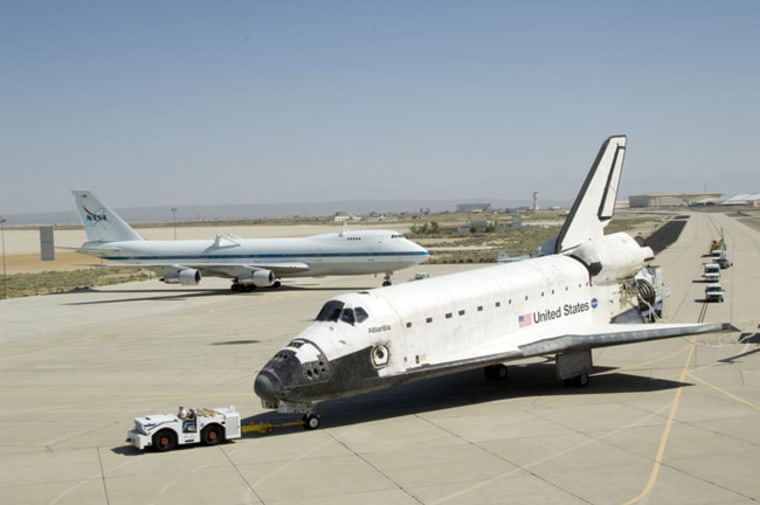Fresh on the heels of a successful flight to the Hubble Space Telescope, NASA is again gearing up to launch a space shuttle into orbit, but bad weather could delay the June spaceflight, mission managers said Thursday.
NASA hopes to launch the shuttle Endeavour on June 13 to deliver the last piece of Japan's massive Kibo laboratory to the international space station during a marathon 16-day construction flight. The space agency also hopes to build on the momentum from the recent Hubble service call, which ended last Sunday when the shuttle Atlantis landed in California.
"We're going to do it again now," said John Shannon, NASA's space shuttle program manager, in a Thursday briefing.
But Endeavour's space station mission has a slim three-day window in which to fly and bad weather in Florida has already delayed the shuttle's planned Saturday move to its launch pad by a day.
"Really, if we don't start to roll on Saturday, then it's going to be a day-for-day impact for the launch," Shannon said. "It's getting very tight."
Stormy weather
Thunderstorms at NASA's Kennedy Space Center in Cape Canaveral, Fla., prevented shuttle technicians from priming Endeavour for its Saturday morning move to a new launch pad.
The shuttle is now slated for a predawn Sunday move to the seaside Launch Pad 39A from its current perch atop the nearby Pad 39B, where it was on standby to fly a rescue missionduring the Hubble flight. No rescue was ever required.
Shannon said it is possible that shuttle technicians could make up the lost time and keep the June 13 target, but he has ordered teams not to rush.
"If the weather doesn't cooperate, then it doesn't cooperate," Shannon said.
Endeavour has until June 15 in which to launch toward the station, after which NASA plans to stand down to allow the June 17 liftoff of a rocket carrying a pair of moon probes — the Lunar Reconnaissance Orbiter and LCROSS impactor — which have weathered a series of flight delays.
If NASA cannot launch Endeavour in June, the next opportunity would arise on July 12. A slip to July should not impact plans to launch at least two more shuttle missions after Endeavour's later this year, Shannon said.
Shannon said Endeavour's mission may also hinge on when the Atlantis can be returned to Florida from its Southern California landing site at Edwards Air Force Base.
Engineers want to make sure a wiring problem that caused a short circuit during Atlantis' May 11 launch will not affect Endeavour, but must wait for the shuttle to be ferried home atop a modified 747 jumbo jet. That process should take about a week, weather permitting.
Ambitious flight ahead
Endeavour commander Mark Polansky, who leads the shuttle's six-man, one-woman crew, said his crew is hoping for an on-time launch, but is prepared for a schedule slip.
"I don't worry about the things that I have no control over," Polansky told reporters Thursday. "For us, we have a mission to do ... we know that when we do, our job is to be ready and carry out the mission and that's what we intend to do."
Polansky and his crew have a daunting mission ahead. It is only the second time that NASA has intentionally scheduled a long, 16-day mission to the space station. Five spacewalks are planned to install a porch-like experiment platform to the end of the station's Japanese Kibo lab, deliver vital spare parts and perform maintenance work.
A one-person swap is also on tap for the station's soon-to-be full, six-person crew. The station is slated to double its crew size to six people early Friday with the arrival of a Russian Soyuz spacecraft carrying three new crewmembers.
Endeavour's mission will be the first ever to see 13 people aboard the space station. Past station-bound shuttle flights, in which the outpost was home to three crewmembers, saw maximum populations of 10 people.
Kirk Shireman, NASA's deputy station program manager, said the jump to 13 people at the station will push the outpost's air-scrubbing capability to its limit. It will also require careful coordination of the station's communications, exercise, sleeping and bathroom facilities.
"We've tried to think of all those things related to having additional people on board," Shireman said. "I think we have a good plan for this."
